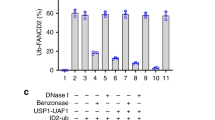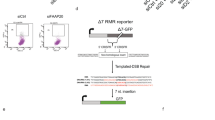Abstract
Fanconi anemia is a recessively inherited disease characterized by congenital defects, bone marrow failure and cancer susceptibility1,2. Cells from individuals with Fanconi anemia are highly sensitive to DNA-crosslinking drugs, such as mitomycin C (MMC). Fanconi anemia proteins function in a DNA damage response pathway involving breast cancer susceptibility gene products, BRCA1 and BRCA2 (refs. 1,2). A key step in this pathway is monoubiquitination of FANCD2, resulting in the redistribution of FANCD2 to nuclear foci containing BRCA1 (ref. 3). The underlying mechanism is unclear because the five Fanconi anemia proteins known to be required for this ubiquitination have no recognizable ubiquitin ligase motifs. Here we report a new component of a Fanconi anemia protein complex, called PHF9, which possesses E3 ubiquitin ligase activity in vitro and is essential for FANCD2 monoubiquitination in vivo. Because PHF9 is defective in a cell line derived from an individual with Fanconi anemia, we conclude that PHF9 (also called FANCL) represents a novel Fanconi anemia complementation group (FA-L). Our data suggest that PHF9 has a crucial role in the Fanconi anemia pathway as the likely catalytic subunit required for monoubiquitination of FANCD2.
This is a preview of subscription content, access via your institution
Access options
Subscribe to this journal
Receive 12 print issues and online access
$209.00 per year
only $17.42 per issue
Buy this article
- Purchase on Springer Link
- Instant access to full article PDF
Prices may be subject to local taxes which are calculated during checkout





Similar content being viewed by others
Accession codes
References
Joenje, H. & Patel, K.J. The emerging genetic and molecular basis of Fanconi anaemia. Nat. Rev. Genet. 2, 446–459 (2001).
D'Andrea, A.D. & Grompe, M. The Fanconi anaemia/BRCA pathway. Nat. Rev. Cancer 3, 23–34 (2003).
Garcia-Higuera, I. et al. Interaction of the Fanconi anemia proteins and BRCA1 in a common pathway. Mol. Cell 7, 249–262 (2001).
Meetei, A.R. et al. A multiprotein nuclear complex connects Fanconi anemia and bloom syndrome. Mol. Cell. Biol. 23, 3417–3426 (2003).
Garcia-Higuera, I., Kuang, Y., Naf, D., Wasik, J. & D'Andrea, A.D. Fanconi anemia proteins FANCA, FANCC, and FANCG/XRCC9 interact in a functional nuclear complex. Mol. Cell. Biol. 19, 4866–4873 (1999).
de Winter, J.P. et al. The Fanconi anemia protein FANCF forms a nuclear complex with FANCA, FANCC and FANCG. Hum. Mol. Genet. 9, 2665–2674 (2000).
Medhurst, A.L., Huber, P.A., Waisfisz, Q., de Winter, J.P. & Mathew, C.G. Direct interactions of the five known Fanconi anaemia proteins suggest a common functional pathway. Hum. Mol. Genet. 10, 423–429 (2001).
Yamashita, T. et al. The fanconi anemia pathway requires FAA phosphorylation and FAA/FAC nuclear accumulation. Proc. Natl. Acad. Sci. USA 95, 13085–13090 (1998).
Pace, P. et al. FANCE: the link between Fanconi anaemia complex assembly and activity. EMBO J. 21, 3414–3423 (2002).
Taniguchi, T. & D'Andrea, A.D. The Fanconi anemia protein, FANCE, promotes the nuclear accumulation of FANCC. Blood 100, 2457–2462 (2002).
Smith, T.F., Gaitatzes, C., Saxena, K. & Neer, E.J. The WD repeat: a common architecture for diverse functions. Trends Biochem. Sci. 24, 181–185 (1999).
Coscoy, L., Sanchez, D.J. & Ganem, D. A novel class of herpes virus-encoded membrane-bound E3 ubiquitin ligases regulates endocytosis of proteins involved in immune recognition. J. Cell. Biol. 155, 1265–1273 (2001).
Hewitt, E.W. et al. Ubiquitylation of MHC class I by the K3 viral protein signals internalization and TSG101-dependent degradation. EMBO J. 21, 2418–2429 (2002).
Lu, Z., Xu, S., Joazeiro, C., Cobb, M.H. & Hunter, T. The PHD domain of MEKK1 acts as an E3 ubiquitin ligase and mediates ubiquitination and degradation of ERK1/2. Mol. Cell 9, 945–956 (2002).
Coscoy, L. & Ganem, D. PHD domains and E3 ubiquitin ligases: viruses make the connection. Trends Cell. Biol. 13, 7–12 (2003).
Agoulnik, A.I. et al. A novel gene, Pog, is necessary for primordial germ cell proliferation in the mouse and underlies the germ cell deficient mutation, gcd. Hum. Mol. Genet. 11, 3047–3053 (2002).
Chen, M. et al. Inactivation of Fac in mice produces inducible chromosomal instability and reduced fertility reminiscent of Fanconi anaemia. Nat. Genet. 12, 448–451 (1996).
Whitney, M.A. et al. Germ cell defects and hematopoietic hypersensitivity to gamma- interferon in mice with a targeted disruption of the Fanconi anemia C gene. Blood 88, 49–58 (1996).
Cheng, N.C. et al. Mice with a targeted disruption of the Fanconi anemia homolog Fanca. Hum. Mol. Genet. 9, 1805–1811 (2000).
Nadler, J.J. & Braun, R.E. Fanconi anemia complementation group C is required for proliferation of murine primordial germ cells. Genesis 27, 117–123 (2000).
Yang, Y. et al. Targeted disruption of the murine Fanconi anemia gene, Fancg/Xrcc9. Blood 98, 3435–3440 (2001).
Koomen, M. et al. Reduced fertility and hypersensitivity to mitomycin C characterize Fancg/Xrcc9 null mice. Hum. Mol. Genet. 11, 273–281 (2002).
Vandenberg, C.J. et al. BRCA1-independent ubiquitination of FANCD2. Mol. Cell 12, 247–254 (2003).
Brunn, D. et al. siRNA depletion of BRCA1, but not BRCA2, causes increased genome instability in Fanconi anemia cells. DNA Repair advance online publication, 16 July 2003 (doi:10.1016/S1568-7864(03)00112-5).
Joenje, H. et al. Classification of Fanconi anemia patients by complementation analysis: evidence for a fifth genetic subtype. Blood 86, 2156–2160 (1995).
Dignam, J.D., Martin, P.L., Shastry, B.S. & Roeder, R.G. Eukaryotic gene transcription with purified components. Methods Enzymol. 101, 582–598 (1983).
Waisfisz, Q. et al. A physical complex of the Fanconi anemia proteins FANCG/XRCC9 and FANCA. Proc. Natl. Acad. Sci. USA 96, 10320–10325 (1999).
Joenje, H., Arwert, F., Eriksson, A.W., de Koning, H. & Oostra, A.B. Oxygen-dependence of chromosomal aberrations in Fanconi's anaemia. Nature 290, 142–143 (1981).
Hoatlin, M.E. et al. The Fanconi anemia group C gene product is located in both the nucleus and cytoplasm of human cells. Blood 91, 1418–1425 (1998).
Aravind L.I.L.M., Koonin, E.V. Scores of rings but no PHDs in ubiquitin signaling. Cell Cycle 2, 123–126 (2003).
Acknowledgements
We thank K. J. Patel for FANCE antibody and communicating unpublished data, M. Grompe for FANCD2 cDNA, Z. Lu and T. Hunter for MEKK1, Y. Qiong for ubiquitin vectors, J. Chen for BRCA1 cells, Y. Yang for ubiquitin reagents, N. Sherman for mass spectrometry identification, J. Qin and L. Li for advice, D. Schlessinger for critical reading of the manuscript and the National Cell Culture Center for providing cells. W.W. has received funding from the Ellison Medical Foundation and Rett Syndrome Research Foundation. This work was also supported by the Dutch Cancer Society (A.L.M. and H.J.V.), the Netherlands Organization for Health Research and Development (J.P.W. and Q.W.) and the US National Institutes of Health (W.W. and M.E.H.).
Author information
Authors and Affiliations
Corresponding author
Ethics declarations
Competing interests
The authors declare no competing financial interests.
Supplementary information
Rights and permissions
About this article
Cite this article
Meetei, A., de Winter, J., Medhurst, A. et al. A novel ubiquitin ligase is deficient in Fanconi anemia. Nat Genet 35, 165–170 (2003). https://doi.org/10.1038/ng1241
Received:
Accepted:
Published:
Issue Date:
DOI: https://doi.org/10.1038/ng1241
This article is cited by
-
Impaired Fanconi anemia pathway causes DNA hypomethylation in human angiosarcomas
Human Cell (2022)
-
MiRNA-200C expression in Fanconi anemia pathway functionally deficient lung cancers
Scientific Reports (2021)
-
The emergence of a unified mechanism in the Fanconi anemia pathway
Genome Instability & Disease (2021)
-
High content drug screening for Fanconi anemia therapeutics
Orphanet Journal of Rare Diseases (2020)
-
Methodology for the identification of small molecule inhibitors of the Fanconi Anaemia ubiquitin E3 ligase complex
Scientific Reports (2020)



